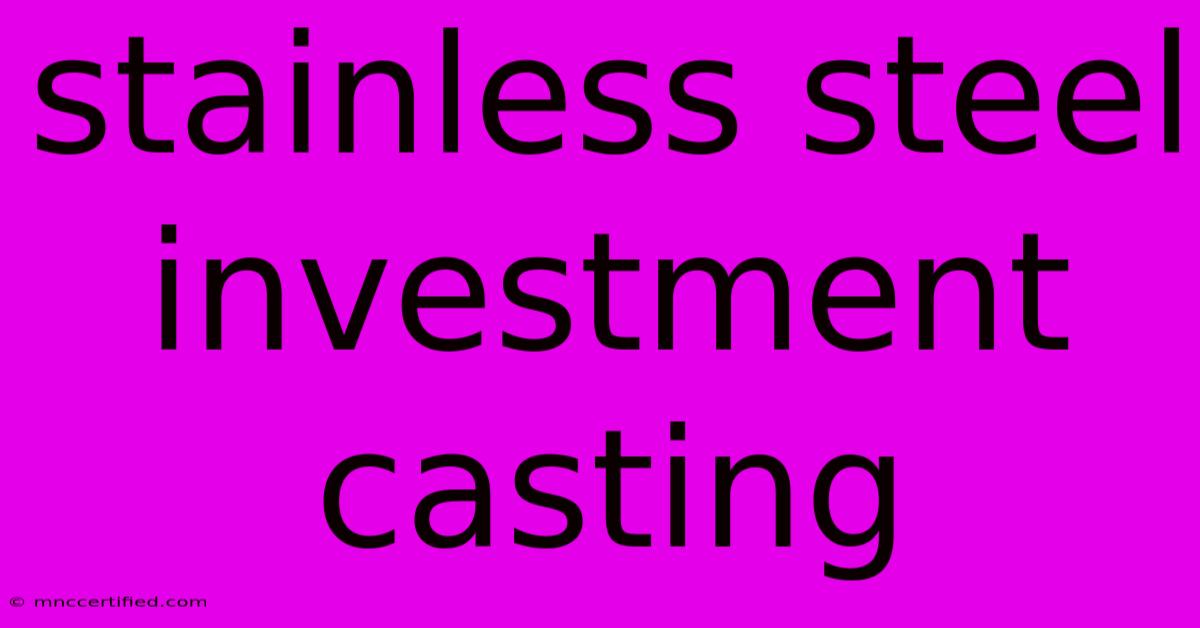Stainless Steel Investment Casting

Table of Contents
Stainless Steel Investment Casting: A Comprehensive Guide
Investment casting, also known as lost-wax casting, is a highly precise metal casting process ideal for creating intricate and complex parts. When combined with the superior properties of stainless steel, it offers a powerful solution for diverse industries. This comprehensive guide explores the intricacies of stainless steel investment casting, highlighting its advantages, applications, and considerations.
What is Stainless Steel Investment Casting?
Stainless steel investment casting involves creating a wax pattern of the desired component, building a ceramic mold around it, melting the wax out, and then pouring molten stainless steel into the resulting cavity. Once cooled and solidified, the ceramic mold is broken away, revealing the finished stainless steel part. This method is particularly suited for stainless steel due to its ability to produce highly detailed components with thin walls and complex geometries, something difficult to achieve with other casting methods.
Advantages of Stainless Steel Investment Casting:
- High Precision and Accuracy: Investment casting yields exceptionally accurate parts with tight tolerances, minimizing the need for machining and post-processing. This translates to cost savings and improved efficiency.
- Complex Geometries: The process excels at creating parts with intricate internal and external features, undercuts, and thin walls – impossible or impractical with other techniques.
- Superior Surface Finish: Investment castings generally boast a smoother surface finish compared to other casting methods, reducing the need for extensive finishing operations. This is especially beneficial for stainless steel, which can be susceptible to surface imperfections during other processes.
- Material Versatility: A wide range of stainless steel grades can be used, allowing for customization based on specific application requirements regarding corrosion resistance, strength, and other properties. 304 stainless steel, 316 stainless steel, and 400 series stainless steel are commonly used.
- Near Net Shape: Minimal material is wasted, resulting in high material utilization and reduced costs.
- Excellent Reproducibility: The process allows for consistent production of identical parts, ensuring quality and reliability across large batches.
Applications of Stainless Steel Investment Casting:
The versatility of stainless steel investment casting makes it suitable for a wide array of industries and applications, including:
- Aerospace: Creating intricate components for aircraft engines, landing gear, and other critical systems.
- Medical: Manufacturing surgical instruments, implants, and other medical devices requiring high precision and biocompatibility.
- Automotive: Producing complex parts for fuel systems, exhaust manifolds, and other high-performance applications.
- Energy: Creating components for power generation and oil & gas extraction equipment, often requiring high corrosion resistance.
- Consumer Goods: Manufacturing high-quality components for watches, jewelry, and other luxury items.
Considerations for Stainless Steel Investment Casting:
While offering numerous advantages, several factors need consideration:
- Cost: Investment casting can be more expensive than other casting methods, particularly for smaller production runs.
- Lead Time: The process can have a longer lead time than some other methods due to the multiple stages involved.
- Mold Design: Designing the wax pattern and ceramic mold requires expertise and precision to ensure a successful casting.
- Material Selection: Choosing the appropriate stainless steel grade is crucial to meet the specific performance requirements of the application.
Choosing a Stainless Steel Investment Casting Supplier:
Selecting the right supplier is critical for successful project completion. Look for a supplier with:
- Extensive Experience: A proven track record in stainless steel investment casting.
- Advanced Technologies: Utilization of modern casting techniques and quality control measures.
- Strong Quality Control: Adherence to strict quality standards and certifications.
- Excellent Communication: Clear communication throughout the entire process.
By carefully considering these factors and selecting a reputable supplier, businesses can leverage the benefits of stainless steel investment casting to produce high-quality, complex components for a wide range of applications. The precision, versatility, and durability of this method make it a leading choice for many industries demanding top-tier performance.

Thank you for visiting our website wich cover about Stainless Steel Investment Casting. We hope the information provided has been useful to you. Feel free to contact us if you have any questions or need further assistance. See you next time and dont miss to bookmark.
Featured Posts
-
Renters Insurance Rancho Cucamonga
Nov 17, 2024
-
Ideas For Investment Company Names
Nov 17, 2024
-
Does Insurance Cover Siding Damage
Nov 17, 2024
-
Lsu Vs Florida Key Matchup
Nov 17, 2024
-
England Vs South Africa Live Score And Updates
Nov 17, 2024